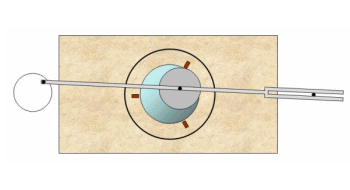They may be classified into three main groups :
|
Draper/Hindle-type machines : This is the mother of all machines. Its principle seems to have been elaborated by Huygens, about 1738, and improved by Lord Rosse, and more recently by Henry Draper, an American astronomer. Here are the different parts which compose this machine (see drawing A) :
|
Place your mouse on some of the pictures to set them in motion :
Figure A : Draper-type machine (single crank) |
| That general concept has been progressively modified and improved : | |
| Ritchey added a side control (1) of the sliding arm, thus enabling an off-axis position of the arm and of the strokes (see B drawing). | 
Figure B : off-axis positioning on a Draper machine |
| A second crank (or reciprocating system) was added in place of the fixed sliding guide, permitting a wider variety of strokes (see figure C). | 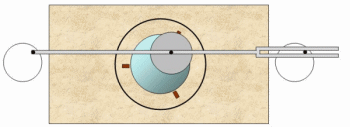
Figure C : Draper machine with a double crank system |
| Hindle alternative:
In his turn, Hindle replaced the drive pin by a frame (1), called alligator, that holds the disk by its side. This device makes it possible to place the mirror on top, which is impossible with the Draper machine. Removing the top disk thus becomes easier, as well as adding pressure onto it with weights whenever necessary (see figure D). |
 Figure D : double-cranked Hindle-type machine Figure D : double-cranked Hindle-type machine |
| Draper-type machine with offset arm :
The main stroke arm (1) has been placed alongside the table. A second arm that can be lifted (2), connected to the first arm, moves the top disk. Its length is usually adjustable. |
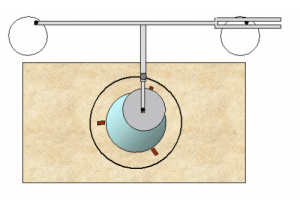 Figure E : double-cranked Draper machine with off-set arm Figure E : double-cranked Draper machine with off-set arm |
| Elgin-Waineo machines :
This is the most common type of machine at the moment, in industry as well as with amateurs, chiefly on the American continent (see figure F). The main difference from the previous model lies in its single off-set arm (1) that oscillates around an axis (2) and is connected to a crank (4) and spindle (3) system which makes it work. This crank is of adjustable length. One famous variation about this design was proposed by an American amateur, optician Tom Waineo in the November 1995 issue of Sky and Telescope. The major drawback of this machine is the limited variety of its movements due to the single eccentric sheave. Yet, some of its most experienced users manage to compensate for this handicap by frequently changing the machine settings. Of course this requires extreme dexterity. Among such users we find Carl Zambuto who has become an expert in the matter.
|
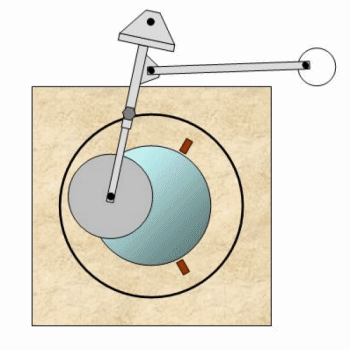 Figure F : Elgin-Waineo machine Figure F : Elgin-Waineo machine |
| Zeiss-type machines :
A production of the famous ex-East-German firm, this machine looks very much like the off-set Draper-type machine (see figure G). It too has two eccentric sheaves but each arm (1 and 2) is directly connected to the drive pin of the lap, creating strokes that are slightly different from the other machine. One of these arms (1) is usually adjustable. |
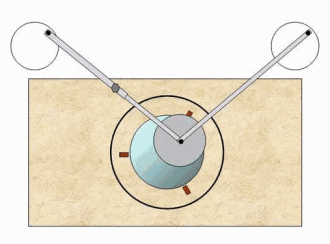 Figure G : Zeiss machine with a pair of eccentric sheaves Figure G : Zeiss machine with a pair of eccentric sheaves |
Here is a concentrated view of the advantages and drawbacks of each type of machine :
|
Criteria |
Machine types |
Mark |
|
Compactness |
Elgin / Waineo
Off-set Draper / Hindle Zeiss Root Draper / Hindle |
+ = = – |
|
Stroke variety |
Zeiss ou Draper / Hindle with double off-set crank
Draper / Hindle or Elgin / Waineo with simple off-set crank |
+
= |
|
Upper or lower position of mirror |
Hindle
Other types |
+ = |
|
Key : + : good / = : fair / – : bad |
|
|

